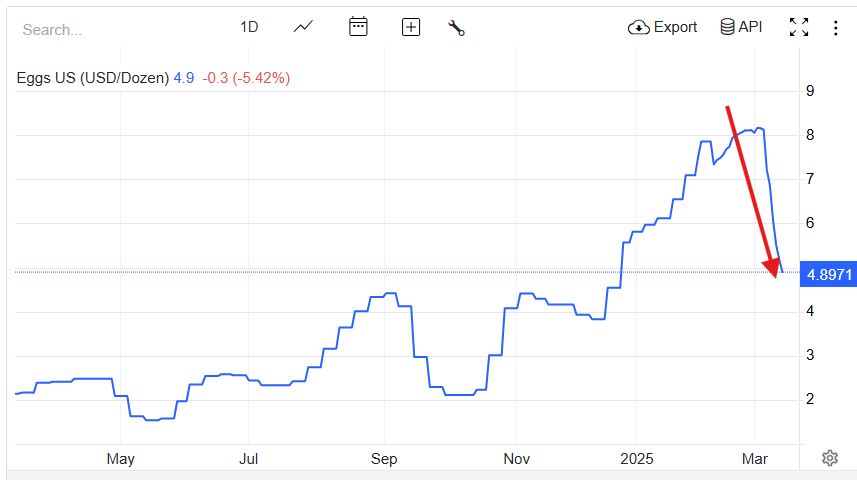Egg Prices Plummet: Dozen Now $5 After Record Highs

Table of Contents
Factors Contributing to the Egg Price Drop
For months, consumers faced skyrocketing egg prices, a situation impacting budgets across the country. Several factors contributed to these record highs:
-
Avian flu outbreaks: The highly pathogenic avian influenza (HPAI) virus devastated poultry flocks across the US, significantly reducing the laying hen population. This massive loss of hens directly translated to egg shortages, driving prices upwards. The impact on egg production was severe, leading to limited supply and increased demand.
-
Increased feed costs: The cost of producing eggs isn't solely dependent on the hens themselves. The price of feed, primarily grains like corn and soybeans, plays a crucial role. Soaring inflation and global supply chain disruptions led to increased feed costs, directly impacting the overall cost of egg production.
-
Inflationary pressures: The broader economic climate of inflation impacted every aspect of egg production and distribution, from fuel costs for transportation to labor expenses at farms and processing plants. These inflationary pressures added to the already escalating cost of eggs.
-
Reduced consumer demand (indirect effect): Ironically, the high prices themselves eventually led to reduced consumer demand. As eggs became increasingly expensive, many consumers substituted them with other protein sources, temporarily easing pressure on the supply chain.
However, several of these factors are now lessening their impact. Avian flu outbreaks are less prevalent, leading to a recovery in the laying hen population. Feed prices, while still elevated, have begun to stabilize, and the overall easing of inflation is contributing to a more balanced market.
Current Egg Prices Across the Country
While a nationwide average is difficult to pinpoint due to regional variations and retailer pricing strategies, a dozen eggs can currently be found for around $5 in many parts of the country. This represents a significant drop from the record highs seen earlier in the year. However, regional discrepancies remain.
-
Regional Variations: Some states in the Midwest are reporting lower average prices, while coastal regions may still see slightly higher costs. This variation is influenced by factors such as local production levels, transportation costs, and retailer markups.
-
Retailer Differences: Prices can vary significantly between different grocery chains and even between different locations of the same chain. Consumers are advised to shop around and compare prices before purchasing.
-
Local Factors: Local factors, such as seasonal production fluctuations and the presence of local farms, can also impact egg prices within a specific region. Supporting local farmers can sometimes provide access to lower prices and fresher eggs.
What This Means for Consumers and Businesses
The drop in egg prices is welcome news for both consumers and businesses:
-
Positive Impacts for Consumers: Lower egg prices mean increased affordability for families, allowing them to incorporate eggs more frequently into their diets without stretching their budgets. This is particularly significant for low-income households that may have reduced egg consumption due to high prices.
-
Implications for Businesses: Food service businesses, from small cafes to large restaurants, will benefit from lower input costs. Bakeries, which heavily rely on eggs, will see a decrease in their production expenses. This could lead to lower menu prices or increased profit margins. Restaurants may have the opportunity to adjust their menus, offering more egg-based dishes or maintaining existing prices while increasing profitability.
Will Egg Prices Stay Low? Predicting the Future
While the current drop in egg prices offers relief, predicting the long-term future is challenging. Several factors could influence future price trends:
-
Seasonal Variations: Egg production naturally fluctuates throughout the year, influenced by factors like weather and hen laying cycles. Prices may rise slightly during periods of lower production.
-
Potential for Future Supply Chain Disruptions: Unexpected events, such as further outbreaks of avian flu, severe weather events affecting transportation, or geopolitical instability, could disrupt the supply chain and lead to price increases.
-
Ongoing Impact of Global Economic Factors: Global economic factors, including inflation and fuel prices, continue to influence the cost of production and distribution. Any resurgence of these factors could put upward pressure on egg prices.
Conclusion:
The recent plummet in egg prices offers much-needed relief to consumers and businesses after months of record highs. While a combination of factors contributed to both the price surge and the subsequent drop, the current lower prices represent a significant positive change. However, it's essential to remain aware of potential factors that could impact future prices.
Call to Action: Keep an eye on egg prices in your area and take advantage of the current affordability. Look for deals on eggs and plan your meals accordingly to benefit from these lower prices. Remember to check back for updates on egg price fluctuations and related market trends! Stay informed on the fluctuating world of egg prices!

Featured Posts
-
 Menko Ahy Bahas Psn Giant Sea Wall Kapan Dimulai Pembangunannya
May 15, 2025
Menko Ahy Bahas Psn Giant Sea Wall Kapan Dimulai Pembangunannya
May 15, 2025 -
 Herstel Van Vertrouwen College Van Omroepen En De Npo
May 15, 2025
Herstel Van Vertrouwen College Van Omroepen En De Npo
May 15, 2025 -
 Should The Bidens Step Back From Politics Aides Perspective
May 15, 2025
Should The Bidens Step Back From Politics Aides Perspective
May 15, 2025 -
 Earthquakes Vs Rapids A Critical Assessment Of Zach Steffens Play
May 15, 2025
Earthquakes Vs Rapids A Critical Assessment Of Zach Steffens Play
May 15, 2025 -
 De Toekomst Van De Npo De Actie Tegen Frederieke Leeflang
May 15, 2025
De Toekomst Van De Npo De Actie Tegen Frederieke Leeflang
May 15, 2025
